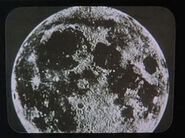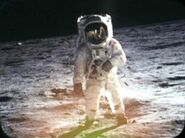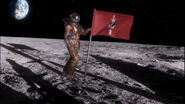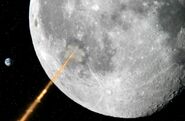m (→Geographical) |
|||
| (46 intermediate revisions by 12 users not shown) | |||
| Line 11: | Line 11: | ||
| Affiliation= [[United Federation of Planets]] |
| Affiliation= [[United Federation of Planets]] |
||
}} |
}} |
||
| ⚫ | |||
| + | == History == |
||
| ⚫ | |||
| + | In the early [[1960s]], [[U.S.]] [[President of the United States|President]] [[John F. Kennedy]] made a speech, stating that a decision was made to transport [[Human]]s to the moon. ({{TOS|The Cage}}) |
||
| + | In the mid-[[20th century]], Luna was depicted on the [[assignment patch|mission insignia]] for ''Apollo 1''. ({{ENT|First Flight}}) |
||
| − | == Astronomical data == |
||
| − | === Location === |
||
| − | [[Earth]], [[Sol system]], Sol sector ([[Sector 001]]), [[Alpha Quadrant]] |
||
| ⚫ | |||
| − | === Historical === |
||
The first manned [[Human]] landing took place in [[1969]] by ''[[Apollo 11]]'', a [[NASA]] mission initiated by the Earth [[nation-state]] of the [[United States of America]]. ({{TOS|Tomorrow is Yesterday|Return to Tomorrow}}) |
The first manned [[Human]] landing took place in [[1969]] by ''[[Apollo 11]]'', a [[NASA]] mission initiated by the Earth [[nation-state]] of the [[United States of America]]. ({{TOS|Tomorrow is Yesterday|Return to Tomorrow}}) |
||
| Line 25: | Line 23: | ||
''In the [[mirror universe]], the [[Terran Empire]] landed on the Moon, planting a flag there to signify their achievement.'' ({{ENT|In a Mirror, Darkly}} ''opening credits'') |
''In the [[mirror universe]], the [[Terran Empire]] landed on the Moon, planting a flag there to signify their achievement.'' ({{ENT|In a Mirror, Darkly}} ''opening credits'') |
||
| + | |||
| − | {{bginfo|The date of this event was unknown, though its placement in the opening credits suggested it happened before 2063. It was also unknown if the individual was the mirror counterpart of Neil Armstrong, though the use of a EV-suit still in use in the mid-22nd century would suggest it wasn't.}} |
||
| ⚫ | |||
In the late [[21st century]] the [[Lunar colonies|Lunar Colonies]] were founded. People who lived in these [[colony|colonies]], even by the [[24th century]], still referred to Luna as "the Moon", though outsiders are often surprised by this. ({{DS9|Valiant}}) |
In the late [[21st century]] the [[Lunar colonies|Lunar Colonies]] were founded. People who lived in these [[colony|colonies]], even by the [[24th century]], still referred to Luna as "the Moon", though outsiders are often surprised by this. ({{DS9|Valiant}}) |
||
| ⚫ | |||
| ⚫ | |||
| + | |||
| + | ''In [[2259]] of the [[alternate reality]], the {{USS|Enterprise|alternate reality}} and the {{USS|Vengeance}} were engaged in [[Battle of Luna|a fire fight]] outside Luna's [[orbit]].'' ({{film|12}}) |
||
| + | |||
| + | In [[2287]], the ''[[Galileo (2287)|Galileo]]'' rendezvoused with the {{USS|Enterprise|NCC-1701-A|-A}} near Luna. ({{film|5}}) |
||
| + | The {{USS|Enterprise|NCC-1701-D|-D}} passed Luna on its way to Earth in [[2364]]. ({{TNG|Conspiracy}}) |
||
| ⚫ | |||
The {{USS|Defiant|2370}} passed Luna on its way to Earth in [[2371]]. ({{DS9|Past Tense, Part I}}) |
The {{USS|Defiant|2370}} passed Luna on its way to Earth in [[2371]]. ({{DS9|Past Tense, Part I}}) |
||
| ⚫ | When attempting a lucid dream to contact a [[species]] of [[alien]]s, [[Chakotay]] used the image of the moon to alert him to the fact that he was dreaming. Chakotay saw the moon three times – once outside the {{USS|Voyager}} from the [[mess hall]], once on a monitor screen in [[Cargo bay|Cargo Bay 2]] after he'd apparently woken up to warn him he was still asleep and under the aliens' control, and once more on the main [[viewscreen]] in the [[bridge]] when he dozed off and was slipping back into the aliens' grip. ({{VOY|Waking Moments}}) |
||
| ⚫ | |||
| + | |||
| ⚫ | |||
| ⚫ | Luna was a central theme in the [[assignment patch|mission insignia]]s for the [[Apollo program]] in the mid-20th century. The first depiction of Luna was in the program's insignia. The insignia depicted the path of the [[spacecraft]] from a launch site in [[Florida]] to a landing site on Luna. Sun god [[Apollo]] was drawn into the features of Luna. As each mission grew closer to landing, the features of Luna became more detailed with cratering and suggested the ship either orbiting above or landing on Luna. By ''Apollo 15'', the lunar features were the dominant image of the insignia. The last lunar mission, ''Apollo 17'', suggested that the program was the first step in man's progression to the stars with Apollo looking beyond Luna to [[Saturn]] and to a distant [[galaxy]]. ({{ENT|First Flight}}) |
||
| + | |||
| ⚫ | |||
As a major Human settlement, Luna fell under [[Federation]] jurisdiction and protection. |
As a major Human settlement, Luna fell under [[Federation]] jurisdiction and protection. |
||
"[[Terra Prime]]", a [[xenophobia|xenophobic]] group of Humans which manifested in [[2155]], originated from the [[Orpheus Mining Colony]] on the Moon. |
"[[Terra Prime]]", a [[xenophobia|xenophobic]] group of Humans which manifested in [[2155]], originated from the [[Orpheus Mining Colony]] on the Moon. |
||
| − | In the late [[24th century]] there were over 50 million people living on the Moon. ({{film|8}}) In Earth [[slang]], people who lived on the moon were called [[Lunar schooner]]s. The occupants of Luna were aware of this but chose not to use the term on the moon. ({{DS9|Valiant}}) |
+ | In the late [[24th century]] there were over 50 million people living on the Moon. ({{film|8}}) In Earth [[slang]], people who lived on the moon were called [[Lunar schooner]]s. The occupants of Luna were aware of this but chose not to use the term on the moon. Additionally, most who had lived on Luna did not actually call it "Luna", this being something that mostly those on Earth said. ({{DS9|Valiant}}) |
| − | + | == Geographical == |
|
Outside the pressure domes of the Lunar Colonies, the gravity was low and there was no air for humans to breathe. The sun came up once a month. This event, known as the lunar morning, was a special occasion for people living on Luna. [[Dorian Collins]] and her father would hike across the [[Sea of Clouds]] towards a scenic spot on the western rim to witness the lunar morning. She described it as meeting [[God]]. ({{DS9|Valiant}}) |
Outside the pressure domes of the Lunar Colonies, the gravity was low and there was no air for humans to breathe. The sun came up once a month. This event, known as the lunar morning, was a special occasion for people living on Luna. [[Dorian Collins]] and her father would hike across the [[Sea of Clouds]] towards a scenic spot on the western rim to witness the lunar morning. She described it as meeting [[God]]. ({{DS9|Valiant}}) |
||
On a clear day on Earth, a person could see [[Tycho City]], [[New Berlin]], and [[Lake Armstrong]]. ({{film|8}}) |
On a clear day on Earth, a person could see [[Tycho City]], [[New Berlin]], and [[Lake Armstrong]]. ({{film|8}}) |
||
| − | |||
| ⚫ | |||
| ⚫ | Luna was a central theme in the [[assignment patch|mission insignia]]s for the [[Apollo program]] in the mid-20th century. The first depiction of Luna was in the program's insignia. The insignia depicted the path of the [[spacecraft]] from a launch site in [[Florida]] to a landing site on Luna. Sun god [[Apollo]] was drawn into the features of Luna. As each mission grew closer to landing, the features of Luna became more detailed with cratering and suggested the ship either orbiting above or landing on Luna. By ''Apollo 15'', the lunar features were the dominant image of the insignia. The last lunar mission, ''Apollo 17'', suggested that the program was the first step in man's progression to the stars with Apollo looking beyond Luna to [[Saturn]] and to a distant [[galaxy]]. ({{ENT|First Flight}}) |
||
| − | |||
| − | === Other information === |
||
| ⚫ | When attempting a lucid dream to contact a [[species]] of [[alien]]s, [[Chakotay]] used the image of the moon to alert him to the fact that he was dreaming. Chakotay saw the moon three times – once outside the {{USS|Voyager}} from the [[mess hall]], once on a monitor screen in [[Cargo bay|Cargo Bay 2]] after he'd apparently woken up to warn him he was still asleep and under the aliens' control, and once more on the main [[viewscreen]] in the [[bridge]] when he dozed off and was slipping back into the aliens' grip. ({{VOY|Waking Moments}}) |
||
=== Locations === |
=== Locations === |
||
| Line 57: | Line 59: | ||
* [[Copernicus City]] |
* [[Copernicus City]] |
||
* [[Copernicus Ship Yards]] |
* [[Copernicus Ship Yards]] |
||
| − | * Lake Armstrong |
+ | * [[Lake Armstrong]] |
* [[Luna Shipyards]] |
* [[Luna Shipyards]] |
||
* [[Lunaport]] |
* [[Lunaport]] |
||
* [[Lunar colonies]] |
* [[Lunar colonies]] |
||
** [[Lunar One colony]] |
** [[Lunar One colony]] |
||
| − | * New Berlin |
+ | * [[New Berlin]] |
* [[Orpheus Mining Colony]] |
* [[Orpheus Mining Colony]] |
||
| − | * Sea of Clouds |
+ | * [[Sea of Clouds]] |
* [[Tranquility Base]] |
* [[Tranquility Base]] |
||
| − | * Tycho City |
+ | * [[Tycho City]] |
| + | {{bginfo|Furthermore, the {{w|Sea of Tranquillity}} was also mentioned indirectly, through the [[USS Mare Tranquillitatis]], and [[Tycho crater]] was mentioned in an unseen portion of the [[Picard family album]].}} |
||
<gallery> |
<gallery> |
||
| − | File: |
+ | File:Earth solar system, The changeling.jpg|Chart 14A: The Sol System. |
File:Sol system, The Cage.jpg|The location of Earth, Luna's primary |
File:Sol system, The Cage.jpg|The location of Earth, Luna's primary |
||
File:Luna, The Cage.jpg|Luna as seen in the ''[[The Cage (episode)|The Cage]]'' (''original'') |
File:Luna, The Cage.jpg|Luna as seen in the ''[[The Cage (episode)|The Cage]]'' (''original'') |
||
| Line 79: | Line 82: | ||
</gallery> |
</gallery> |
||
| + | {{SolSystem}} |
||
| − | === Background Information === |
||
| − | ==== ''The Explored Galaxy'' ==== |
||
| − | This chart was first seen, chronologically, in [[2293]]. ({{film|6}}) This chart was also seen in several ''[[Star Trek: The Next Generation]]'' and ''[[Star Trek: Deep Space Nine]]'' episodes set in the [[24th century]], from the year [[2364]] to [[2370]]. These were: {{TNG|Conspiracy|The Measure Of A Man|The Emissary|The Mind's Eye|The Game}} and {{DS9|In the Hands of the Prophets|Cardassians}}. |
||
| − | |||
| − | ==== ''[[Star Trek: Star Charts]]'' ==== |
||
| ⚫ | Moon (Sol IIIa) was a [[Class D |
||
| − | |||
| − | Specifications for the Moon: |
||
| − | |||
| − | * '''Diameter''': 3,476 km |
||
| − | * '''Distance from Earth''': 384,500 km |
||
| − | * '''Surface Temperature''': -155 °C to 105 °C |
||
| − | * '''Rotation Period''': 27.3 days |
||
| − | * '''Orbital Period''': 27.3 days |
||
| − | * '''Gravity''': 0.16 standard |
||
| − | * '''Orbital Facilities''': Lunaport |
||
| − | |||
| − | '''Source''': Pages 32 and 38 |
||
| − | + | == Appendices== |
|
| ⚫ | |||
| − | Luna (Moon) was the natural satellite of Earth. This satellite had a slightly elliptical orbit. At perigee, the Moon was located at 356,000 kilometers (221,600 miles) from the Earth. When the Moon was at apogee, it was located at 406,997 kilometers (252,950 miles) from the Earth. The Moon's mean diameter was 3,475 kilometers (2,160 miles), and it's mass was 1/80 that of Earth. Though the surface of the moon was mostly barren and cratered, there were deposits of water hidden under the surface. The tenuous atmosphere of the Moon was composed largely of [[sodium]]. The average period of revolution for the moon, when calculated with respect to the sun, was 29 days 12 hours 44 seconds. |
||
| + | [[File:Luna, Earth and sun, TNG opening sequence.jpg|thumb|Luna surrounding the Earth and the sun as seen in the TNG opening sequence]] |
||
| ⚫ | According to ''[[Star Trek: Star Charts]]'' (Pgs. 32, "United Federation of Planets I"), The Moon (or Sol IIIa) was classified as a [[Class D|D-class moon]]. In [[2039]], the Lunar Colonies, the uniglobal government of the Moon, was founded. Tycho City was the seat of government. In [[2161]], the Moon was a charter member of the United Federation of Planets. In [[2378]], Humans were the dominant species, and there were counted 50.2 million living on the Moon. Points of interest included Tranquility Base, Lake Armstrong, New Berlin, and Lunaport. |
||
| + | Luna appeared in the opening sequence of the [[remastered]] ''[[Star Trek: The Next Generation]]'', seen surrounding the [[Earth]] and the [[Sol|sun]] and followed by [[Jupiter]] and [[Saturn]] before the {{USS|Enterprise|NCC-1701-D|-D}} started its exploration of the unknown space. |
||
| − | Luna was the Roman goddess of the Moon. |
||
| − | == External |
+ | === External links === |
* {{wikipedia|Moon}} |
* {{wikipedia|Moon}} |
||
| + | * {{NCwiki|Luna}} |
||
[[cs:Měsíc]] |
[[cs:Měsíc]] |
||
Revision as of 04:43, 27 July 2014
AT: "xx" Luna (or The Moon) was the inhabited sole natural satellite of the planet Earth in the Sol system.
History
In the early 1960s, U.S. President John F. Kennedy made a speech, stating that a decision was made to transport Humans to the moon. (TOS: "The Cage")
In the mid-20th century, Luna was depicted on the mission insignia for Apollo 1. (ENT: "First Flight")
The first manned Human landing took place in 1969 by Apollo 11, a NASA mission initiated by the Earth nation-state of the United States of America. (TOS: "Tomorrow is Yesterday", "Return to Tomorrow")
The first man to walk on the Moon was Neil Armstrong, who said "That's one small step for [a] man, one giant leap for mankind." Shannon O'Donnell remembered watching it on television when she was eleven years old, and still had dreams about it inspiring her career with NASA in 2000. (VOY: "11:59")
In the mirror universe, the Terran Empire landed on the Moon, planting a flag there to signify their achievement. (ENT: "In a Mirror, Darkly" opening credits)
In 2063, Luna's gravitational field obscured the USS Enterprise-E's warp signature so that the Vulcan starship, the T'Plana-Hath, would not detect it while in Earth orbit as they were making First Contact with Humans. (Star Trek: First Contact)
In the late 21st century the Lunar Colonies were founded. People who lived in these colonies, even by the 24th century, still referred to Luna as "the Moon", though outsiders are often surprised by this. (DS9: "Valiant")
By 2155, Luna had evolved from a mere colony to a fully self-sustaining world. That same year, John Frederick Paxton used the hijacked verteron array on Mars to fire on Luna, as a demonstration of the array's power. (ENT: "Demons")
In 2259 of the alternate reality, the USS Enterprise and the USS Vengeance were engaged in a fire fight outside Luna's orbit. (Star Trek Into Darkness)
In 2287, the Galileo rendezvoused with the USS Enterprise-A near Luna. (Star Trek V: The Final Frontier)
The USS Enterprise-D passed Luna on its way to Earth in 2364. (TNG: "Conspiracy")
The USS Defiant passed Luna on its way to Earth in 2371. (DS9: "Past Tense, Part I")
When attempting a lucid dream to contact a species of aliens, Chakotay used the image of the moon to alert him to the fact that he was dreaming. Chakotay saw the moon three times – once outside the USS Voyager from the mess hall, once on a monitor screen in Cargo Bay 2 after he'd apparently woken up to warn him he was still asleep and under the aliens' control, and once more on the main viewscreen in the bridge when he dozed off and was slipping back into the aliens' grip. (VOY: "Waking Moments")
Depictions in the Apollo program
Luna was a central theme in the mission insignias for the Apollo program in the mid-20th century. The first depiction of Luna was in the program's insignia. The insignia depicted the path of the spacecraft from a launch site in Florida to a landing site on Luna. Sun god Apollo was drawn into the features of Luna. As each mission grew closer to landing, the features of Luna became more detailed with cratering and suggested the ship either orbiting above or landing on Luna. By Apollo 15, the lunar features were the dominant image of the insignia. The last lunar mission, Apollo 17, suggested that the program was the first step in man's progression to the stars with Apollo looking beyond Luna to Saturn and to a distant galaxy. (ENT: "First Flight")
Political
As a major Human settlement, Luna fell under Federation jurisdiction and protection.
"Terra Prime", a xenophobic group of Humans which manifested in 2155, originated from the Orpheus Mining Colony on the Moon.
In the late 24th century there were over 50 million people living on the Moon. (Star Trek: First Contact) In Earth slang, people who lived on the moon were called Lunar schooners. The occupants of Luna were aware of this but chose not to use the term on the moon. Additionally, most who had lived on Luna did not actually call it "Luna", this being something that mostly those on Earth said. (DS9: "Valiant")
Geographical
Outside the pressure domes of the Lunar Colonies, the gravity was low and there was no air for humans to breathe. The sun came up once a month. This event, known as the lunar morning, was a special occasion for people living on Luna. Dorian Collins and her father would hike across the Sea of Clouds towards a scenic spot on the western rim to witness the lunar morning. She described it as meeting God. (DS9: "Valiant")
On a clear day on Earth, a person could see Tycho City, New Berlin, and Lake Armstrong. (Star Trek: First Contact)
Locations
- Armstrong City
- Copernicus City
- Copernicus Ship Yards
- Lake Armstrong
- Luna Shipyards
- Lunaport
- Lunar colonies
- Lunar One colony
- New Berlin
- Orpheus Mining Colony
- Sea of Clouds
- Tranquility Base
- Tycho City
Template:SolSystem
Appendices
Background information
Luna surrounding the Earth and the sun as seen in the TNG opening sequence
According to Star Trek: Star Charts (Pgs. 32, "United Federation of Planets I"), The Moon (or Sol IIIa) was classified as a D-class moon. In 2039, the Lunar Colonies, the uniglobal government of the Moon, was founded. Tycho City was the seat of government. In 2161, the Moon was a charter member of the United Federation of Planets. In 2378, Humans were the dominant species, and there were counted 50.2 million living on the Moon. Points of interest included Tranquility Base, Lake Armstrong, New Berlin, and Lunaport.
Luna appeared in the opening sequence of the remastered Star Trek: The Next Generation, seen surrounding the Earth and the sun and followed by Jupiter and Saturn before the USS Enterprise-D started its exploration of the unknown space.







